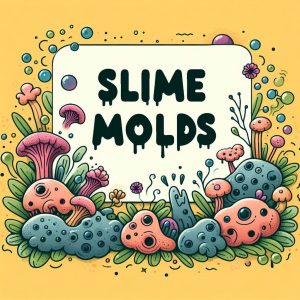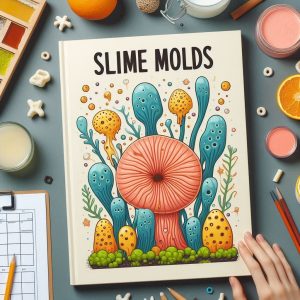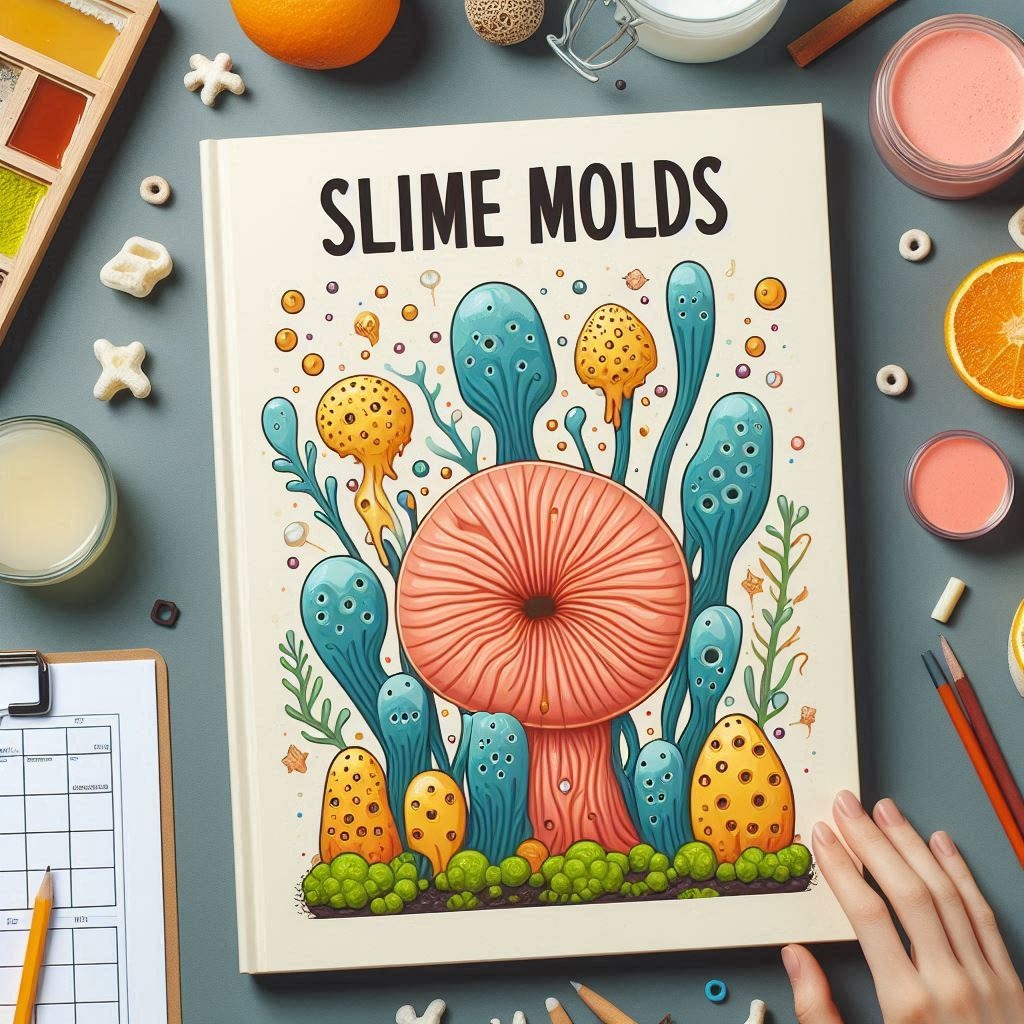Slime Molds
Introduction to Slime Molds
Slime molds are a unique group of organisms that have intrigued scientists and naturalists for centuries. Though often mistaken for fungi, slime molds belong to the kingdom Protista. These fascinating organisms exhibit characteristics of both fungi and amoebas during different stages of their life cycle.

Types of Slime Molds
Slime molds are classified into three main groups based on their morphology and life cycle:
Plasmodial Slime Molds (Myxomycetes)
Plasmodial slime molds, also known as Myxomycetes, are the most commonly recognized type. They exist as a large, single-celled, multinucleate mass of cytoplasm called a plasmodium. The plasmodium moves by cytoplasmic streaming, engulfing bacteria, spores, and other organic matter. When conditions are unfavorable, the plasmodium differentiates into fruiting bodies that produce spores. These spores can withstand harsh environmental conditions and germinate when conditions improve.
Cellular Slime Molds (Dictyostelids)
Cellular slime molds, or Dictyostelids, are characterized by their unique life cycle, which includes both unicellular and multicellular stages. In the unicellular stage, these organisms exist as free-living amoeboid cells that feed on bacteria. When food is scarce, the amoeboid cells aggregate to form a multicellular structure known as a pseudoplasmodium or slug. The slug migrates to a suitable location and differentiates into a fruiting body, releasing spores that develop into new amoeboid cells under favorable conditions.
Protostelid Slime Molds
Protostelid slime molds are less well-known compared to plasmodial and cellular slime molds. They are typically smaller and simpler in structure. Protostelids have a life cycle that involves the formation of a single, small fruiting body from a single amoeboid cell. These slime molds are often found in soil and leaf litter, where they feed on bacteria and other microorganisms.
Life Cycle of Slime Molds
The life cycle of slime molds involves both unicellular and multicellular stages. In plasmodial slime molds, the life cycle begins with haploid spores that germinate into amoeboid cells. These cells fuse to form a diploid plasmodium, which is a large, multinucleate mass of cytoplasm. The plasmodium moves through its environment by cytoplasmic streaming, engulfing food particles along the way. When conditions become unfavorable, the plasmodium forms fruiting bodies that release spores, completing the cycle.
| Stage | Plasmodial Slime Molds | Cellular Slime Molds |
|---|---|---|
| Spore | Haploid spores | Haploid spores |
| Amoeboid Cells | Form from germinating spores | Form from germinating spores |
| Aggregation | Cells fuse to form a plasmodium | Cells aggregate to form a pseudoplasmodium |
| Fruiting Body | Forms to release spores | Forms to release spores |
Ecological Importance
Slime molds play a significant role in ecosystems, particularly in forest habitats. They contribute to the decomposition of organic matter, recycling nutrients back into the soil. This process supports plant growth and maintains soil health. Additionally, slime molds serve as a food source for various invertebrates and other microorganisms.
One of the critical roles of slime molds is their participation in the decomposition process. As they move through their environment, slime molds engulf bacteria, fungi, and other small particles of organic matter. This decomposition process breaks down complex organic materials into simpler substances that plants and other organisms can use for growth.
Furthermore, slime molds are essential indicators of ecosystem health. Because they are sensitive to changes in environmental conditions, the presence and diversity of slime molds in an area can provide valuable information about soil quality, moisture levels, and overall habitat health. Monitoring slime mold populations can help ecologists assess the impact of environmental changes, such as climate change, pollution, and habitat destruction, on ecosystems.
Slime molds also contribute to soil structure and fertility. As they move and feed, they create small channels in the soil, which improve aeration and water infiltration. This process helps maintain a healthy soil structure, which is vital for plant roots and other soil organisms. Additionally, the nutrients released by slime molds during decomposition are essential for the growth of plants and the overall productivity of the ecosystem.
Research and Discoveries
Recent research has shed light on the complex behaviors and intelligence of slime molds. Studies have shown that slime molds can navigate mazes, optimize nutrient acquisition, and even exhibit memory-like behaviors. These findings have implications for understanding basic biological processes and developing new approaches in fields such as robotics and network optimization.
Fascinating Facts about Slime Molds
- Slime molds can move at a speed of up to 1 millimeter per hour. Despite their slow pace, this movement is efficient for navigating through their environment in search of food.
- They can form structures resembling fungi during their reproductive stage. When conditions are right, slime molds aggregate and form fruiting bodies that release spores into the environment.
- Some slime molds can solve complex problems, such as finding the shortest path through a maze. Researchers have used slime molds in experiments to model and understand optimization problems, demonstrating their surprising problem-solving abilities.
- Slime molds exhibit a form of memory without a nervous system. They can “remember” and react to previously encountered environmental conditions, helping them adapt and survive in changing habitats.
- They play a vital role in ecosystems as decomposers, breaking down dead organic matter and recycling nutrients back into the soil, which supports plant growth and maintains soil health.
- Slime molds can exist in both unicellular and multicellular states. In their unicellular form, they act as amoeboid cells, while in their multicellular state, they function as a coordinated organism.
- The study of slime molds has inspired advances in robotics and network optimization. Their ability to efficiently navigate and solve problems has provided insights into designing more effective algorithms and robotic systems.
- Slime molds have been found in various habitats around the world, from forests to deserts. Their adaptability allows them to thrive in diverse environmental conditions.
- Slime molds can produce a wide range of pigments, resulting in vibrant colors such as yellow, orange, and red. These colors can be seen in their fruiting bodies and plasmodium stages.
- They have a unique way of reproducing that involves the fusion of individual cells to form a single, multinucleated cell. This process helps them survive and reproduce in different environmental conditions.
- Slime molds can form sclerotia, which are hardened, dormant structures that allow them to survive unfavorable conditions. When conditions improve, the sclerotia can reactivate and resume normal activity.
- Some species of slime molds can produce bioluminescent fruiting bodies, emitting a faint glow in the dark. This fascinating feature adds to their mysterious and captivating nature.
- Slime molds have been studied for their potential in biotechnology, including applications in drug discovery and environmental monitoring. Their unique properties continue to inspire scientific research and innovation.
Conclusion
Slime molds are extraordinary organisms that challenge our understanding of life and intelligence. Their unique life cycles, fascinating behaviors, and significant ecological roles highlight their importance in the natural world. From their efficient decomposition of organic matter to their surprising problem-solving abilities, slime molds continue to intrigue scientists and nature enthusiasts alike. As research progresses, we uncover more about their complex interactions with the environment and their potential applications in various fields. Slime molds not only contribute to ecosystem health but also inspire innovations in science and technology, proving that even the most humble organisms can have a profound impact on our understanding of the world.
Frequently Asked Questions about Slime Molds

- What are slime molds? Slime molds are a diverse group of eukaryotic organisms that can live as single cells but can aggregate to form multicellular reproductive structures. They are not fungi, plants, or animals, but belong to the kingdom Protista.
- Where can slime molds be found? Slime molds can be found in a variety of environments, including forests, lawns, decaying logs, and leaf litter. They thrive in moist, shady areas rich in organic material.
- How do slime molds reproduce? Slime molds reproduce by forming fruiting bodies that release spores into the environment. These spores can germinate into new slime mold cells when conditions are favorable.
- Are slime molds harmful to humans? Slime molds are generally harmless to humans. They do not cause disease or pose any significant health risks. However, some people may experience allergic reactions to airborne spores.
- What is the life cycle of a slime mold? The life cycle of a slime mold involves several stages, including spore germination, amoeboid cell formation, aggregation, and fruiting body formation. This cycle can vary depending on the species.
- Can slime molds move? Yes, slime molds can move. In their plasmodial stage, they exhibit amoeboid movement, allowing them to crawl over surfaces in search of food.
- What do slime molds eat? Slime molds primarily feed on bacteria, fungi, and decaying organic matter. They play a crucial role in decomposing organic material and recycling nutrients in ecosystems.
- How do slime molds solve problems? Slime molds can solve problems through a form of collective intelligence. For example, they can find the shortest path through a maze by extending their plasmodium and retracting unsuccessful paths.
- What are the different types of slime molds? There are three main types of slime molds: plasmodial slime molds (Myxomycetes), cellular slime molds (Dictyosteliomycetes), and protostelid slime molds (Protosteliomycetes). Each type has distinct characteristics and life cycles.
- Why are slime molds important in ecosystems? Slime molds are important decomposers in ecosystems. They break down dead organic matter, releasing nutrients back into the soil, which supports plant growth and maintains soil health.
- Can slime molds form networks? Yes, slime molds can form networks known as plasmodial networks. These networks enable them to efficiently explore their environment and distribute nutrients throughout their bodies.
- Do slime molds have any applications in science and technology? Slime molds have inspired advances in various fields, including robotics, network optimization, and bio-computing. Their problem-solving abilities and efficient movement patterns provide valuable insights for designing algorithms and systems.
- What is the difference between slime molds and fungi? Slime molds and fungi are distinct organisms. Slime molds belong to the kingdom Protista, while fungi belong to the kingdom Fungi. Unlike fungi, slime molds do not have cell walls made of chitin and exhibit amoeboid movement.
- How can I observe slime molds?You can observe slime molds in nature by looking for them in moist, shaded areas rich in organic material. They can also be cultured on agar plates with a suitable food source in the laboratory.
Disclaimers and Cautions
General Disclaimer: The information provided about slime molds is for educational and informational purposes only. While we strive to ensure the accuracy and completeness of the content, we cannot guarantee that all information is entirely accurate, complete, or up to date. Scientific understanding of slime molds is constantly evolving, and discoveries may alter current knowledge.
Health and Safety: Although slime molds are generally harmless to humans, some individuals may experience allergic reactions to airborne spores. If you have a history of allergies or respiratory conditions, take precautions when handling or being close to slime molds. If you experience any adverse reactions, seek medical advice immediately.
Environmental Impact: Avoid disturbing their environment when observing or collecting slime molds in their natural habitat. Slime molds play a crucial role in ecosystem health, and excessive collection or habitat disruption can negatively impact local biodiversity. Always practice responsible and ethical fieldwork.
Laboratory Handling: When culturing slime molds in a laboratory setting, follow standard laboratory safety protocols. Ensure that all materials used in the cultivation process are properly sterilized to prevent contamination. Dispose of any biological waste by local regulations.
Use of Information: The content provided is not intended to be used as a basis for any medical, environmental, or scientific decision-making without consulting qualified professionals. Always seek expert advice before making any decisions based on the information provided about slime molds.
Intellectual Property: All content, including text, images, and graphics related to slime molds, is protected by copyright and other intellectual property laws. Unauthorized use or reproduction of any part of this content without proper attribution or permission is prohibited.
Research and References: The information provided is based on current scientific literature and research available at the time of writing. For further reading and more detailed information, refer to reputable sources and scientific publications. Always verify facts and consult primary research articles when conducting in-depth studies on slime molds.
External Links: This document may contain links to external websites for further reading and resources. We do not endorse or take responsibility for the content on external sites. Use discretion when accessing external links and verify the credibility of the information provided on those sites.
Changes to Content: We reserve the right to update, modify, or remove any content related to slime molds at any time without prior notice. Stay informed about the latest developments in the field of slime mold research by consulting updated scientific sources regularly.
Further Reading and Resources
For more information about slime molds, you can visit the following resources:



